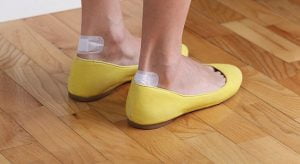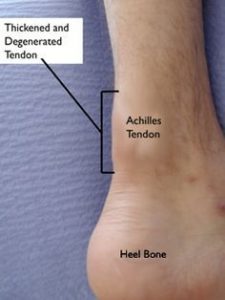If you have ever suffered blisters due to your boots or shoes rubbing against your Achilles, heels, foot top, and ankles, you know how painful it is. The friction caused by the continuous contact causes tiny breaks on your skin, resulting in a break out of blisters.
Luckily, you can avoid this issue by wearing appropriate socks, inserting an insole or heel cup, and minimizing moisture in your boots. Moreover, you can stick a band-aid on the affected area, apply Vaseline, invest in anti-friction sticks, or duct tape. It’s also essential to break in your new boots.
Individuals who work jobs that need them to be on their feet for many hours will greatly benefit from learning how to prevent blisters. These people include electricians, servers, retail workers, and construction workers.
Table of Contents
11 Simple Ways To Stop Boots From Rubbing Your Heel
Heels are highly susceptible to blisters since they are under intense pressure all day long. The friction caused between the ankle and Achilles and shoe lining makes your shoes rub against your heel.
You can avoid it through the following methods.
1. Break In Your New Boots
It’s common knowledge that new shoes or boots hurt more than old ones because they are still hard, resulting in more skin rubbing. It will take some time before they can comfortably conform to the size and shape of your feet.
You can prevent your boots from rubbing your heels by breaking them in faster. Do so by using a shoe stretcher, inserting bags of them in them, then freezing them, putting on thick socks or multiple socks at once, or buying blister plasters.
Related: How do you break in new boots fast?
2. Wear Long Socks
Short socks expose more of your skin to friction, causing blisters and pain. Protect your heels by wearing that cover, at the very least past the shoe’s collar or topline.
3. Wear Thick Socks
If long socks don’t offer enough protection to your heels, consider thicker ones. They will help keep your feet in place by filling up the additional gap in your boots, thus preventing the shoes from rubbing the bone of the side ankle.
Ensure the socks have arch support and extra cushioning to stabilize your feet, reducing movement hence less friction. Alternatively, you can put on more than one pair of socks to raise the fabric thickness.
4. Put On Liner Socks
They will serve as a wall between your heel and socks working as a protective barrier even when the boots rub against the outer socks.
5. Use Insole
Insoles cushion your feet and curb them from wriggling, preventing friction. Ensure your insoles are high quality for proper protection because poor ones will not offer enough support and cause excessive movement.
You can go for orthotic insoles as they are designed for positioning, arch support, and correct posture. In addition, they can offer a more secure and tighter fit preventing blister-causing friction.
You can also find decent insoles for boots off the shelf or go for customized ones, but that will come at a higher cost.
6. Apply Vaseline On Your Heels
Vaseline is slippery, so it will make your feet slide against your boots, reducing friction.
7. Put A Heel Grip Inside The Boots
A heel grip is a foam or gel-made oval-shaped cushion strip with an adhesive attached to one side and covered using moleskin. Attach the heel grip on the inner side of the boot where your heel lies after removing the adhesive.
8. Get Anti-friction Sticks
This balm functions like Vaseline that creates an invisible barrier hence preventing friction.
9. Use A Band-Aid
Band-aid is an easy solution to reduce rubbing. All you need to do is stick it at the back of your heels before putting on your boots.
10. Use Duct Tape
Attach duct tape on your heels before wearing your boots to stop rubbing and reduce friction, protecting you from blisters.
11. Apply Antiperspirant Roll-ons
Sweat can cause blisters, so it’s essential to keep your feet dry with the help of antiperspirants.
How To Stop Shoes From Rubbing Achilles?
The Achilles are vulnerable to rubbing, chaffing, abrasions, and blisters. Therefore, it’s vital to protect these parts while walking on new boots.
You can do so in the following ways.
a) Use Duct Tape
Duct tape functions like a band-aid, protecting your skin from rubbing, bruises, and blisters. Paste the tape on your Achilles area after peeling off the adhesive layer.
b) Achilles Shield (A Pair Of Vertical Insoles)
This works to protect your tendon areas against the abrasive part of new boots, preventing bruises, abrasions, and blisters.
c) Get An Insole
Put an insole on your boot’s Achilles area to get proper cushioning and deter blisters and rubbing. If you can fit them yourself, take the shoes to a cobbler.
d) Cotton Pads
Put two to three cotton pads on your Achilles area, then wear your socks to create a barrier between the shoes and the Achilles.
How Do I Stop My Boots Rubbing The Back Of Ankle?
Your boots can rub against the back of your ankle, causing blisters and even cuts. This happens when the shoes have an uneven fit, are small, or are made using hard material.
Here are some remedies you should try.
1. Gel Cushions
Gel cushions form a layer of gel over the ankles, making sure the boots don’t rub against your ankles.
2. Silicon Heel Cups
Ankle pains can be caused by poor arch support, which makes them move a lot, causing rubbing, cuts, and blisters.
The other methods are:
- Put on thick socks
- Break-in the boots
- Put an insole
- Insert wool into the toe-boxes
- Stretch the boots with heat or ice
- Prevent flip-flops by adding cushioning to the thong part
How To Stop Shoes From Rubbing Top Of Foot?
You need to protect the top of your feet from rubbing against your shoes. Here are some simple ways to do so.
1. Put Protective Sleeve Over Your Feet
Footbridge protectors provide cushioning to your feet against shear force, impact, and pressure using a gel pad that ensures your feet don’t rub the boots.
2. Put On Thick Socks
Thick socks create a bridge between the top of your boots and feet, preventing them from rubbing against each other, preventing blisters and pain.
3. Use Top Of The Foot Support
This prevents pain caused by excess pressure. The pads are exceptionally soft since they utilize soft foam to create a protective layer.
4. Stretch The Shoes
You can stretch your boots if they don’t fit snugly with a shoe stretcher or heat with a dryer. You can also fill water into a freezer bag, put it into the shoe, and place it in the freezer.
5. Make the Boots’ Inside Top Part Even With Sandpaper
The top part of your feet will hurt if the shoe’s inner part is slippery. Luckily, you can prevent this by rubbing the top inner part of the boot with sandpaper to make it even, thus increasing traction.
Conclusion
Getting yourself a new pair of boots is exciting, but before you can enjoy wearing it, take time to break it in. In addition, prevent them from rubbing against the back of your ankle, heels, top of the foot, and Achilles.
Most importantly, keep your feet fresh, dry, and clean.
